Spring详解(七)------AOP 注解
上一篇博客我们讲解了 AspectJ 框架如何实现 AOP,然后具体的实现方式我们是通过 xml 来进行配置的。xml 方式思路清晰,便于理解,但是书写过于麻烦。这篇博客我们将用 注解 的方式来进行 AOP 配置。
为了便于大家理解,讲解方式是这样的,我们先给出 xml 的配置,然后介绍如何通过 注解 来进行替代。
PS:本篇博客源码下载链接:http://pan.baidu.com/s/1dFdBHZF 密码:3v4k
1、xml 的方式实现 AOP
①、接口 UserService
package com.ys.aop;
public interface UserService {
//添加 user
public void addUser();
//删除 user
public void deleteUser();
}
②、实现类 UserServiceImpl
package com.ys.aop;
public class UserServiceImpl implements UserService{
@Override
public void addUser() {
System.out.println("增加 User");
}
@Override
public void deleteUser() {
System.out.println("删除 User");
}
}
③、切面类,也就是通知类 MyAspect
package com.ys.aop;
import org.aspectj.lang.JoinPoint;
public class MyAspect {
/**
* JoinPoint 能获取目标方法的一些基本信息
* @param joinPoint
*/
public void myBefore(JoinPoint joinPoint){
System.out.println("前置通知 : " + joinPoint.getSignature().getName());
}
public void myAfterReturning(JoinPoint joinPoint,Object ret){
System.out.println("后置通知 : " + joinPoint.getSignature().getName() + " , -->" + ret);
}
public void myAfterThrowing(JoinPoint joinPoint,Throwable e){
System.out.println("抛出异常通知 : " + e.getMessage());
}
public void myAfter(){
System.out.println("最终通知");
}
}
④、AOP配置文件 applicationContext.xml
<?xml version="1.0" encoding="UTF-8"?>
<beans xmlns="http://www.springframework.org/schema/beans"
xmlns:xsi="http://www.w3.org/2001/XMLSchema-instance"
xmlns:context="http://www.springframework.org/schema/context"
xmlns:aop="http://www.springframework.org/schema/aop"
xsi:schemaLocation="http://www.springframework.org/schema/beans
http://www.springframework.org/schema/beans/spring-beans.xsd
http://www.springframework.org/schema/aop
http://www.springframework.org/schema/aop/spring-aop.xsd
http://www.springframework.org/schema/context
http://www.springframework.org/schema/context/spring-context.xsd">
<!--1、创建目标类 -->
<bean id="userService" class="com.ys.aop.UserServiceImpl"></bean>
<!--2、创建切面类(通知) -->
<bean id="myAspect" class="com.ys.aop.MyAspect"></bean> <!--3、aop编程
3.1 导入命名空间
3.2 使用 <aop:config>进行配置
proxy-target-class="true" 声明时使用cglib代理
如果不声明,Spring 会自动选择cglib代理还是JDK动态代理
<aop:pointcut> 切入点 ,从目标对象获得具体方法
<aop:advisor> 特殊的切面,只有一个通知 和 一个切入点
advice-ref 通知引用
pointcut-ref 切入点引用
3.3 切入点表达式
execution(* com.ys.aop.*.*(..))
选择方法 返回值任意 包 类名任意 方法名任意 参数任意 -->
<aop:config>
<aop:aspect ref="myAspect">
<!-- 切入点表达式 -->
<aop:pointcut expression="execution(* com.ys.aop.*.*(..))" id="myPointCut"/>
<!-- 3.1 前置通知
<aop:before method="" pointcut="" pointcut-ref=""/>
method : 通知,及方法名
pointcut :切入点表达式,此表达式只能当前通知使用。
pointcut-ref : 切入点引用,可以与其他通知共享切入点。
通知方法格式:public void myBefore(JoinPoint joinPoint){
参数1:org.aspectj.lang.JoinPoint 用于描述连接点(目标方法),获得目标方法名等
-->
<aop:before method="myBefore" pointcut-ref="myPointCut"/> <!-- 3.2后置通知 ,目标方法后执行,获得返回值
<aop:after-returning method="" pointcut-ref="" returning=""/>
returning 通知方法第二个参数的名称
通知方法格式:public void myAfterReturning(JoinPoint joinPoint,Object ret){
参数1:连接点描述
参数2:类型Object,参数名 returning="ret" 配置的
-->
<aop:after-returning method="myAfterReturning" pointcut-ref="myPointCut" returning="ret" /> <!-- 3.3 最终通知 -->
<aop:after method="myAfter" pointcut-ref="myPointCut"/> </aop:aspect>
</aop:config>
</beans>
⑤、测试
@Test
public void testAop(){
ApplicationContext context = new ClassPathXmlApplicationContext("applicationContext.xml");
UserService useService = (UserService) context.getBean("userService");
useService.addUser();
useService.deleteUser();
}
⑥、控制台打印结果

上面的例子很简单,就是在 UserService 的 addUser()方法和 deleteUser()方法增加前置通知和后置通知,这在实际操作中很好理解。比如这是和数据库打交道的话,那么我们在 addUser() 或者 deleteUser() 时,必须要在前面开始事务,操作完毕后提交事务。下面我们就用注解的方式来配置。
2、注解实现 AOP
①、导入相应的 jar 包,以及在 applicationContext.xml 文件中导入相应的命名空间。这个在上面的源码下载链接中都有

<?xml version="1.0" encoding="UTF-8"?>
<beans xmlns="http://www.springframework.org/schema/beans"
xmlns:xsi="http://www.w3.org/2001/XMLSchema-instance"
xmlns:context="http://www.springframework.org/schema/context"
xmlns:aop="http://www.springframework.org/schema/aop"
xsi:schemaLocation="http://www.springframework.org/schema/beans
http://www.springframework.org/schema/beans/spring-beans.xsd
http://www.springframework.org/schema/aop
http://www.springframework.org/schema/aop/spring-aop.xsd
http://www.springframework.org/schema/context
http://www.springframework.org/schema/context/spring-context.xsd"> </beans>
②、注解配置 bean
xml配置:
<!--1、创建目标类 -->
<bean id="userService" class="com.ys.aop.UserServiceImpl"></bean>
<!--2、创建切面类(通知) -->
<bean id="myAspect" class="com.ys.aop.MyAspect"></bean>
注解配置:
目标类:

切面类:

③、配置扫描注解识别
这个我们在前面也讲过,上面配置的注解,Spring 如何才能识别这些类上添加了注解呢?我们必须告诉他。
在 applicationContext.xml 文件中添加如下配置:
<!-- 配置扫描注解类
base-package:表示含有注解类的包名。
如果扫描多个包,则下面的代码书写多行,改变 base-package 里面的内容即可!
-->
<context:component-scan base-package="com.ys.aop"></context:component-scan>
④、注解配置 AOP
一、我们用xml配置过如下:

这是告诉 Spring 哪个是切面类。下面我们用注解配置
我们在切面类上添加 @Aspect 注解,如下:

二、如何让 Spring 认识我们所配置的 AOP 注解呢?光有前面的类注解扫描是不够的,这里我们要额外配置 AOP 注解识别。
我们在 applicationContext.xml 文件中增加如下配置:
<!--2、确定 aop 注解生效 -->
<aop:aspectj-autoproxy></aop:aspectj-autoproxy>
三、注解配置前置通知
我们先看 xml 配置前置通知如下:
<!-- 切入点表达式 -->
<aop:pointcut expression="execution(* com.ys.aop.*.*(..))" id="myPointCut"/>
<!-- 3.1 前置通知
<aop:before method="" pointcut="" pointcut-ref=""/>
method : 通知,及方法名
pointcut :切入点表达式,此表达式只能当前通知使用。
pointcut-ref : 切入点引用,可以与其他通知共享切入点。
通知方法格式:public void myBefore(JoinPoint joinPoint){
参数1:org.aspectj.lang.JoinPoint 用于描述连接点(目标方法),获得目标方法名等
-->
<aop:before method="myBefore" pointcut-ref="myPointCut"/>
那么注解的方式如下:

四、注解配置后置通知
xml 配置后置通知:
<!-- 3.2后置通知 ,目标方法后执行,获得返回值
<aop:after-returning method="" pointcut-ref="" returning=""/>
returning 通知方法第二个参数的名称
通知方法格式:public void myAfterReturning(JoinPoint joinPoint,Object ret){
参数1:连接点描述
参数2:类型Object,参数名 returning="ret" 配置的
-->
<aop:after-returning method="myAfterReturning" pointcut-ref="myPointCut" returning="ret" />
注意看,后置通知有个 returning="ret" 配置,这是用来获得目标方法的返回值的。
注解配置如下:

五、测试
@Test
public void testAopAnnotation(){
ApplicationContext context = new ClassPathXmlApplicationContext("applicationContext_Annotation.xml");
UserService useService = (UserService) context.getBean("userService");
useService.addUser();
useService.deleteUser();
}
六、控制台打印结果

3、注解改进
我们可以看前置通知和后置通知的注解配置:

注意看红色框住的部分,很显然这里是重复的,而且如果我们有多个通知方法,那就得在每个方法名都写上该注解,而且如果包名够复杂,也很容易写错。那么怎么办呢?
解决办法就是声明公共切入点:
①、在 切面类 MyAspect.java 中新增一个切入点方法 myPointCut(),然后在这个方法上添加 @Pointcut 注解

②、那么前置通知和后置通知,我们可以进行如下改写配置:

4、总结
上面我们只进行了前置通知和后置通知的讲解,还有比如最终通知、环绕通知、抛出异常通知等,配置方式都差不多,这里就不进行一一讲解了。然后我们看一下这些通知的注解:
@Aspect 声明切面,修饰切面类,从而获得 通知。
通知
@Before 前置
@AfterReturning 后置
@Around 环绕
@AfterThrowing 抛出异常
@After 最终
切入点
@PointCut ,修饰方法 private void xxx(){} 之后通过“方法名”获得切入点引用
Spring详解(七)------AOP 注解的更多相关文章
- Spring框架系列(9) - Spring AOP实现原理详解之AOP切面的实现
前文,我们分析了Spring IOC的初始化过程和Bean的生命周期等,而Spring AOP也是基于IOC的Bean加载来实现的.本文主要介绍Spring AOP原理解析的切面实现过程(将切面类的所 ...
- Spring框架系列(10) - Spring AOP实现原理详解之AOP代理的创建
上文我们介绍了Spring AOP原理解析的切面实现过程(将切面类的所有切面方法根据使用的注解生成对应Advice,并将Advice连同切入点匹配器和切面类等信息一并封装到Advisor).本文在此基 ...
- Iptables详解七层过滤
<Iptables详解七层过滤> 一.防火墙简介 防火墙其实就是一个加固主机或网络安全的一个设备或者软件而已,通过防火墙可以隔离风险区域与安全区域的连接,同时不会妨碍风险区域的访问.当然需 ...
- Spring详解(六)------AOP 注解
上一篇博客我们讲解了 AspectJ 框架如何实现 AOP,然后具体的实现方式我们是通过 xml 来进行配置的.xml 方式思路清晰,便于理解,但是书写过于麻烦.这篇博客我们将用 注解 的方式来进行 ...
- spring定时任务详解(@Scheduled注解)( 转 李秀才的博客 )
在springMVC里使用spring的定时任务非常的简单,如下: (一)在xml里加入task的命名空间 xmlns:task="http://www.springframework.or ...
- Spring详解(五)------AOP
这章我们接着讲 Spring 的核心概念---AOP,这也是 Spring 框架中最为核心的一个概念. PS:本篇博客源码下载链接:http://pan.baidu.com/s/1skZjg7r 密码 ...
- [Spring学习笔记 3 ] spring 注解详解,完全注解,常用注解
.xml使用注解 xml 用来定义bean的信息,注解用来配置依赖信息 ) 在配置文件中配置bean )在javaBean中用注解来指定依赖注入 )在配置文件中开启注解扫描 @Resource标签 j ...
- Spring详解篇之 AOP面向切面编程
一.概述 Aop(aspect oriented programming面向切面编程),是spring框架的另一个特征.AOP包括切面.连接点.通知(advice).切入点(pointCut) . 1 ...
- Spring详解(一)------概述
本系列教程我们将对 Spring 进行详解的介绍,相信你在看完后一定能够有所收获. 1.什么是 Spring ? Spring是一个开源框架,Spring是于2003 年兴起的一个轻量级的Java 开 ...
随机推荐
- 安卓学习 intent
其实学习了好几个星期了,是看老罗的视频,但进度太慢 今天 换了一本书 Intent 切换页面 啊啊啊啊 CompentName comp=new CompentName(MainActivity.th ...
- SqlServer数据库链接字符串
完整链接字符串: 1."DataSourse=.\你的实例;Initial Catalog=yourdatabase;User ID=*;Password=*;Trusted_Connect ...
- [并查集][NOIP2015]信息传递
信息传递 题目描述 有 N 个同学( 编号为 1 到 N) 正在玩一个信息传递的游戏. 在游戏里每人都有一个固定的信息传递对象, 其中,编号为i的同学的信息传递对象是编号为ti的同学. 游戏开始时, ...
- 《Java并发编程的艺术》Java并发机制的底层实现原理(二)
Java并发机制的底层实现原理 1.volatile volatile相当于轻量级的synchronized,在并发编程中保证数据的可见性,使用 valotile 修饰的变量,其内存模型会增加一个 L ...
- shell脚本学习-练习写一个脚本2
# 1.依次展示/var目录下的对象,并说明是文件或者目录.格式如:Hello,$file. # 2.统计一个有多少个文件. #!/bin/bash #Program Description: #Au ...
- 关于Visual Studio调试C/C++,JS,PHP,JAVA,Python等语言的方法
我在开始接触vs code后,确实对它的高颜值和小巧灵活而着迷,但是有一个非常现实的问题,相对于vs来说,vscode是一个代码编辑器,而不是一个IDE,在代码编译运行上存在着极大的问题,尤其是开始编 ...
- XBee® ZigBee 模块使用方法
Digi的ZigBee模块简称S2,根据芯片版本的不同历史上分别有S2,S2B,S2C等,每次硬件平台升级,都会引入一个新的尾缀字母.历史版本中S2和S2B已经停产并被S2C替代.当前S2C是主流平台 ...
- docker服务各个模块
docker容器官网:https://hub.docker.com/ 一.centos7.4中指定安装docker版本 1)默认yum源安装的docker版本为docker1.3.性能偏低,不支持k8 ...
- ubuntu18.04静态ip设置
1.配置文件 vi /etc/netplan/-cloud-init.yaml network: ethernets: enp129s0f0: addresses: [] dhcp4: true op ...
- (PMP)解题技巧和典型题目分析(0903-3班)
B.项目有依赖 D A A B B C B C D B A B B A B
